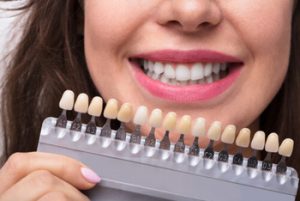When it comes to achieving a healthy and attractive smile, you’ve got some fantastic options in the world of cosmetic dentistry, and two of the most popular choices are dental crowns and veneers.
“So, what sets these two procedures apart, and which fits my needs and goals best?”
These are precisely what we’re going to answer within this article.
We’ll guide you through the differences between veneers and crowns, helping you gain the knowledge you need to make an informed decision about your dental health and gain a dazzling smile.
Chapter One: Crowns VS Veneers
Veneers VS Crowns: What’s The Difference?
Dental veneers and crowns are considered dental restoration procedures, but they serve different purposes and have distinct characteristics that set them apart.
Here’s a breakdown of the key differences between veneers and crowns:
1. Purpose
- Dental Crown: Crowns are primarily used to restore and protect severely crooked or chipped teeth. They cover the entire salient portion of the existing tooth above the gumline, providing strength and support.
- Dental Veneer: Veneers are used for cosmetic purposes to enhance the appearance of teeth with minor imperfections. Since they cover only the front surface of the existing tooth and are designed to improve aesthetics, your healthy natural tooth remains pretty much unchanged.
2. Tooth Preparation
- Dental Crown: Crown placement often requires extensive tooth preparation because it covers the entire tooth, which involves removing a substantial portion of the tooth enamel to accommodate the crown.
Dental Veneer: Veneers involve minimal tooth reduction. The tooth’s enamel is usually lightly buffed to create space for the veneer, but most of the natural tooth structure is retained.
3. Tooth Coverage
- Dental Crown: A dental crown covers the entire tooth, including the biting surface. Crowns provide comprehensive protection and support for teeth that have suffered substantial damage.
- Dental Veneer: Veneers cover only the front tooth surface, addressing cosmetic concerns like staining, minor chips, or irregularities in tooth shape.
4. Material Thickness
- Dental Crown: Crowns are thicker than veneers since they need to provide structural integrity and withstand biting forces.
- Dental Veneer: Veneers are thin shells, usually made of porcelain or composite resin, and bonded to the front of the tooth. Dental veneers are thinner and more translucent, which means they’re less likely to make your teeth’s gum margin show after years.
5. Indications
- Dental Crown: Crowns are recommended for damaged or cracked teeth, or ones with extensive decay, large fillings, fractures, after root canal treatment, or as part of bridge placement.
- Dental Veneer: Veneers are suitable for patients with minor cosmetic concerns, such as discoloured, stained, slightly misaligned, or irregularly shaped teeth.
6. Strength And Durability
- Dental Crown: Crowns provide exceptional strength and are better suited for restoring severely damaged or weakened teeth.
- Dental Veneer: Veneers are not intended for heavy biting forces and may be more susceptible to chipping or damage if exposed to excessive pressure.
7. Tooth Preservation
- Dental Crown: Crowns require more tooth reduction, leading to the removal of healthy tooth structure.
- Dental Veneer: Veneers are a more conservative option, as they preserve most of the natural tooth structure.
8. Treatment Time
- Dental Crown: The placement of crowns typically involves two dental visits. The first visit includes tooth preparation, impressions, and placement of a temporary crown, while the second visit involves the placement of the permanent crowns.
- Dental Veneer: Veneers can often be completed in a single visit, making them a faster cosmetic solution.
Dental crowns are used for therapeutic purposes, offering strength and protection to damaged teeth, while dental veneers focus on cosmetic improvements with minimal alteration to the natural tooth structure.
The matter of veneers vs crowns depends on your dental needs and aesthetic goals, as determined by your dentist.
Chapter Two: Dental Crowns
What Are Dental Crowns?
Often called dental caps, dental crowns are custom-made covers that encase an entire tooth. They work on restoring the actual size, shape, strength, and appearance of your existing teeth.
Crowns are crafted from different materials, such as porcelain and composite resins.
What Are Different Types of Crowns?
Here’s an overview of what dental crowns can look like based on different materials:
 Porcelain And Ceramic Crowns: These crowns are highly aesthetic and often used for front teeth or visible areas in the smile. They’re mostly colour-matched to the shade of your natural teeth.
Porcelain And Ceramic Crowns: These crowns are highly aesthetic and often used for front teeth or visible areas in the smile. They’re mostly colour-matched to the shade of your natural teeth.
Porcelain and ceramic crowns imitate the appearance of natural tooth enamel, making them virtually indistinguishable from real teeth.- Composite Resin Crowns: Composite resin crowns are made from the same material used for tooth-coloured fillings. They’re mostly colour-matched to your natural teeth but may have a different level of transparency than porcelain crowns.
These crowns are suitable for restoring front teeth and areas where aesthetics are important. - Temporary Crowns: Temporary crowns are often made from acrylic or stainless steel. They are pre-fabricated and serve as placeholders until the permanent crown is ready.
A temporary crown isn’t as aesthetically pleasing as a permanent crown and may have a more generic appearance.
Dental crowns blend in with surrounding teeth as closely as possible, providing functional and aesthetic benefits.
The choice of crown material depends on various factors, including the tooth’s location, aesthetic preferences, and dentist’s recommendations.
Your dentist will work with you to select the most appropriate crown material to achieve the desired appearance and function.
When Are Crowns Recommended?
Dental crowns are recommended to address specific dental issues and restore teeth’ health, function, and appearance. Here are common scenarios in which crowns are recommended:
1. To Protect Weakened Teeth
Crowns are often used to protect teeth weakened due to extensive decay, large fillings, or fractures. They provide strength and support to the whole tooth, preventing further damage.
2. After Root Canal Treatment
Teeth that undergo root canal therapy are usually more brittle and prone to fractures. Crowns are placed over these teeth to protect them from breaking and to restore their function.
3. To Restore Broken Or Fractured Teeth
When a whole tooth is broken or fractured due to trauma or injury, a crown can be used to rebuild and reinforce the tooth’s structure.
4. For Large Fillings
Teeth with large fillings that compromise their structural integrity may require crowns to stabilise and prevent further damage.
5. As Part of a Dental Bridge
Crowns are used to anchor a bridge. They are placed on the teeth adjacent to a gap (where a tooth is missing) to support the bridge and replace the missing tooth.
6. To Cover Discoloured Or Misshapen Teeth
Crowns can improve the appearance of teeth with severe discolouration, irregular shape, or cosmetic imperfections. They provide a natural, aesthetically pleasing look.
7. To Address Excessive Wear
Teeth that have worn down significantly over time, either due to grinding or erosion, may benefit from crowns to restore their original size, shape, and function.
8. To Replace Old Crowns
Old deteriorated crowns that become discoloured or no longer fit properly may need to be replaced to maintain oral health and aesthetics.
9. For Cosmetic Enhancement
While veneers are a more conservative option for cosmetic improvements, crowns may be recommended when more substantial changes are needed to improve the appearance of teeth, such as altering their size or shape.
10. After Dental Implant Placement
Crowns are used as the visible portion of dental implants. They are attached to the implant’s abutment to replace missing teeth. Find further details.
11. For Pediatric Dentistry
Children may sometimes require dental crowns to treat severely decayed or damaged primary (baby) teeth. These crowns protect the primary teeth until they naturally fall out.
The specific recommendation for a dental crown depends on the patient’s oral health, the extent of the dental issue, and their individual needs and goals.
Dentists carefully evaluate each case to determine whether getting a crown is the most suitable option.
Regular dental checkups and consultations with a dentist can help identify when crowns are necessary to maintain and improve oral health.
What’s The Dental Crown Procedure?
The procedure of getting a crown involves two visits to your professional dentist. During your very first visit, the dentist will prepare the tooth by removing damaged and decayed portions and reshaping them to accommodate the crown.
An impression of the tooth will be taken, serving as a model for creating the custom crown. A temporary crown might be placed to protect the tooth until your permanent crown is all set and ready.
Once the permanent crown is fabricated in a dental lab, you’ll return for the second visit, and the crown will be cemented into its designated place.
Dental crowns can last for at least a decade with proper care, providing both functionality and an aesthetically pleasing appearance.
Chapter Three: Dental Veneers
What Are Dental Veneers?
Dental veneers are ultra-thin shells bonded to a tooth’s front surface.
Veneers are primarily used for cosmetic purposes, enhancing the appearance of your smile by improving your teeth’s colour, shape, size, or alignment.
What Are Different Types Of Veneers?
Dental veneers come in several different types, each with its characteristics and advantages. These types include:
 Porcelain Veneers: These are the most common and widely used veneers because they provide a natural-looking solution for most cosmetic dental issues, given their great durability and resistance to stain.
Porcelain Veneers: These are the most common and widely used veneers because they provide a natural-looking solution for most cosmetic dental issues, given their great durability and resistance to stain.- Composite Veneers: Composite veneers are customised using a tooth-coloured resin material. However, they’re more prone to staining and less durable than porcelain veneers.
- Temporary Veneers: Just like temporary crowns, temporary veneers cover the teeth until permanent veneers are ready, whether composite veneers or porcelain veneers.
The choice of veneer type depends on various factors, including your specific cosmetic goals, budget, and your dentist’s recommendation.
It’s essential to consult a dental professional who understands your needs and guides you in selecting the most suitable type of veneer for your smile makeover.
When Are Veneers Recommended?
Dental veneers are recommended in various situations to enhance the appearance of teeth and improve a person’s smile. Here are common scenarios in which veneers are recommended:
1. Teeth Whitening
Dental veneers are a great option for dental patients with severe tooth discolouration or staining that doesn’t respond well to traditional teeth whitening methods. Veneers provide a long-lasting, white smile.
2. Reshaping Irregular Teeth
Teeth with irregular shapes or sizes, such as small or misshapen teeth, can be improved with veneers. Veneers create a more uniform and harmonious appearance.
3. Closing Gaps
Veneers can close small gaps or spaces between teeth, providing a more even and aesthetically pleasing smile. The veneer procedure is a minimally invasive alternative to orthodontic treatment.
4. Repairing Chipped Or Crooked Teeth
Teeth that are chipped, worn, or have minor damage can be restored with veneers. They cover the damaged areas and restore the tooth’s appearance.
5. Alignment Of Slightly Crooked Teeth
While not a replacement for orthodontic treatment, veneers can make minor adjustments to the appearance of slightly crooked teeth, creating the illusion of a straighter smile.
6. Lengthening Short Teeth
Veneers can lengthen teeth that appear shorter than desired, improving the smile’s proportions and enhancing facial aesthetics.
7. Conservative Cosmetic Solution
Veneers are more of a conservative option than crowns because they require less removal of natural tooth structure, which makes them an attractive choice for cosmetic improvements.
8. Permanent Stain Resistance
Porcelain veneers are incredibly resistant to stains, making them suitable for individuals concerned about staining from coffee, tea, or smoking.
It’s essential to consult with a cosmetic dentist to know if veneers are the perfect fit for your specific dental concerns and goals.
The dentist will meticulously evaluate your oral health and discuss the most suitable treatment plan to achieve your desired results.
Veneers can be a transformative option for those looking to enhance their smile and achieve a more appealing appearance.
What’s The Dental Veneer Procedure?
Getting dental veneers typically requires about two to three visits. During your very first visit, the dentist will focus on your goals and examine your teeth to determine if veneers suit you.
If so, the dentist will prepare your teeth by peeling about half a millimetre of enamel to make room for the veneers.
Next, your dentist will take various impressions of your teeth to create custom veneers that match your natural teeth in shape and colour.
You may wear a temporary veneer until the permanent veneer is ready. In the final appointment, the dentist will bond the veneers to your teeth, ensuring they fit perfectly and look natural.
Frequently Asked Questions
Are dental crowns permanent?
Dental crowns are durable and long-lasting but might require replacement after several years because of normal wear and tear.
Can I get both crowns and veneers for a complete smile makeover?
Combining crowns and veneers can provide a comprehensive smile transformation, addressing cosmetic and structural concerns.
Does dental insurance cover crowns and veneers?
Dental insurance may cover some of your out-of-pocket expenses when it comes to crowns and veneers if deemed medically necessary. Cosmetic procedures may not be fully covered.
Veneers VS Crowns: Choosing The Right Match
Choosing between crowns and veneers depends on your unique dental needs and aesthetic goals. While both procedures offer remarkable benefits, consulting with a qualified cosmetic dentist is the key to making the right decision.
A skilled dentist will always consider the condition of your teeth, oral health, and desired outcomes to help you achieve the smile you’ve always dreamed of. Feel free to ring Dapto Dentists, NSW, at (02) 4062 8724. Our cosmetic and restorative dentistry professionals will help you regain a dazzling smile!
Sources
Colgate. “Different Types of Dental Crowns.” Mar. 2022, www.colgate.ie/oral-health/bridges-and-crowns/different-types-of-dental-crowns-0215.
Fletcher, Jenna. What to Know About Dental Veneers. 29 May 2020, www.medicalnewstoday.com/articles/dental-veneers.
Dental Crown Procedure. www.healthdirect.gov.au/dental-crown-procedure.
Larson, Jennifer. “Everything You Need to Know About Getting a Dental Crown.” 31 Oct. 2019, www.healthline.com/find-care/articles/dentists/dental-crown.
Dental Veneers: Procedure and Safety. 13 Feb. 2023, www.news-medical.net/health/Dental-Veneers-Procedure-and-Safety.aspx.
Cleveland Clinic Medical. “Veneers.” my.clevelandclinic.org/health/treatments/23522-dental-veneers.
Sztyler, Klaudia, et al. “Review on Preformed Crowns in Pediatric Dentistry—The Composition and Application.” Materials, vol. 15, no. 6, Multidisciplinary Digital Publishing Institute, Mar. 2022, p. 2081. https://doi.org/10.3390/ma15062081.
Difference Between Veneers and Crowns. 23 Apr. 2021, www.webmd.com/oral-health/difference-between-veneers-and-crowns.



 Porcelain And Ceramic Crowns: These crowns are highly aesthetic and often used for front teeth or visible areas in the smile. They’re mostly colour-matched to the shade of your natural teeth.
Porcelain And Ceramic Crowns: These crowns are highly aesthetic and often used for front teeth or visible areas in the smile. They’re mostly colour-matched to the shade of your natural teeth.




